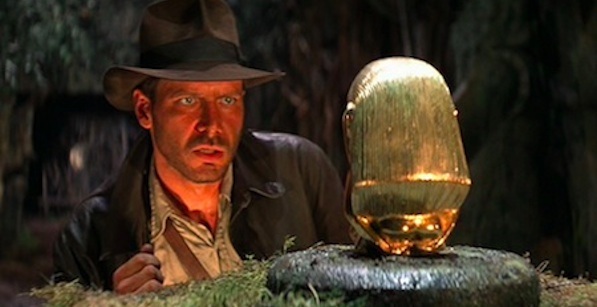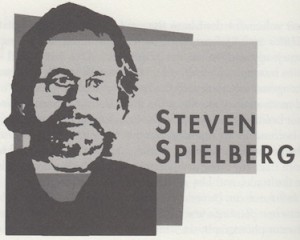
Born: December 18, 1947, Cincinnati, OH
Spielberg and George Lucas—they aren’t wunderkinder anymore. They have to produce.
—Judith Crist
*Editor’s note: Fifteen years later, the essays of Scott Smith’s 1998 book, The Film 100, are being republished here on Keyframe, not as the last word on cinema—as much has changed in film in the past two decades–but as a starting point for further discussion. Please join the conversation. To view the entire Film 100 list and find links to all the essays, please visit Reintroducing the Film 100.
Today, the motion picture business is a high-stakes game that requires deep resources to stay competitive. As the average budget for an action movie rises above $100 million*, there is little room for films that cannot draw audiences by the millions. Currently considered Hollywood’s premiere power broker, self-taught filmmaker Steven Spielberg is perhaps the perhaps most responsible for this condition. His successes have consistently outperformed those of his peers, and collectively his films have been seen by more people than any other director’s in the history of Hollywood. This phenomenal track record has pushed Spielberg to uncharted heights in Hollywood and established him as the prototype of the twenty-first-century filmmaker. His films have virtually become entertainment industries in themselves, creating opportunities to franchise film stories and characters into consumer merchandise, multimedia computer games and television shows. To sustain this long line of profits, every film must be a blockbuster—and nobody creates blockbusters like Steven Spielberg.
Spielberg’s short film Amblin’ (1969) led to an assignment directing Joan Crawford in the pilot episode of Rod Serling’s Night Gallery series in 1970. For a brief period, he continued directing installments on other series, including Columbo and Marcus Welby, M.D. His keen sense for dramatic structure earned him a feature-length made-for-TV movie, Duel (1971), which became a critical surprise. The film was released theatrically and became a solid commercial success.
After The Sugarland Express (1974), he leveraged the rich heritage of Hollywood’s most exciting and profitable genres: fantasy, horror and science fiction. He realized that films like Dr. Jekyll and Mr. Hyde, Metropolis, Nosferatu and The Cabinet of Dr. Caligari had outgrossed many of the films of esteemed directors like Jean Renoir, Charlie Chaplin and D.W. Griffith. So Spielberg decided to make a monster movie.
Jaws (1975) launched Hollywood’s alarming climb to the blockbuster era by becoming the highest-grossing movie of all time, breaking the record set by Francis Ford Coppola’s The Godfather (1972). Jaws was a unique thriller that spawned several sequels and send-ups. It began the summer tradition of competing action films, all vying for the spending money of baby boomers by using action-oriented scripts and special effects. By the time Spielberg’s follow-up hit, Close Encounters of the Third Kind (1977), was released, he had put himself into an elite stratosphere of huge financial players, where filmmakers could hardly risk a failure.
Inevitably, there would be colossal flops, like the disappointing 1941 (1979), Empire of the Sun (1987), Always (1989) and the $60 million Hook (1991). But along with the flops, there was a steady stream of monumental successes. In Raiders of the Lost Ark (1981), which introduced the adventurer Indiana Jones, Spielberg attempted to re-create the feeling that cliffhanger serials had given him as a kid. Two other Indiana Jones movies would follow, both directed by Spielberg, and the character’s youth would be chronicled in a George Lucas television series.
By Raiders, he had established himself as a director with a rare insight into the type of entertainment that struck a familiar and friendly chord with mainstream audiences. His films were eagerly anticipated, and his name on a film, even if only as producer, assured audiences of quality escapist fare. He topped the box office again with E.T. the Extra-Terrestrial (1982), which was immediately hailed as the definitive Spielberg classic, becoming the largest money-maker to date; it was the impetus for dozens of films that put children and aliens together.
Tired of the perception that he was a “soft” director, Spielberg became interested in stories that had more challenges than simply earning enormous receipts. He set out to earn respect for his technical skill with some more thought-provoking projects. His first attempt, the exceptional adaptation of Alice Walker’s controversial novel The Color Purple (1985), was well received by audiences, but Spielberg’s direction was ignored by the Academy. Finally, he received the critical acknowledgement he sought with Schindler’s List (1993), a sprawling exposé of the Holocaust; it garnered seven Oscars including Best Picture, Best Director and Best Adapted Screenplay. Subsequently, each film would make more than $100 million, proving that his artful endeavors did not have to come at the expense of ticket sales.
As a savvy executive producer, Spielberg backed Poltergeist (1982), Gremlins (1984), The Goonies (1985), Back to the Future (1985) and Who Framed Roger Rabbit? (1988), among hundreds of others. Through his production company, Amblin Entertainment, Spielberg diversified into TV projects, including Amazing Stories, the daily animated series Tiny Toon Adventures, a throwback to the Leon Schlesinger productions of Warner Bros. cartoons and the undersea adventure SeaQuest DSV. Soon, Spielberg’s empire became a well-oiled entertainment machine.
Spielberg’s business acumen was evident in his $70 million special effects adventure Jurassic Park (1993). The most aggressively marketed film in history, its $1 billion worldwide revenues (including merchandising) shattered all previous movie records. His second computer-generated dinosaur film, The Lost World (1997), made $100 million in just five days, the shortest time ever.
Steven Spielberg’s name at the helm of an entertainment project has come to symbolize a standard of quality that is surpassed only by the Disney studios and the MGM of the forties. With a new production company he cofounded, DreamWorks SKG, he is poised to continue his winning ways. He is able to hand-pick more ambitious projects such as Amistad (1997) that allow him to showcase his directorial skills, while keeping a tight grip on more profitable productions that DreamWorks develops by leveraging his considerable clout. His expanded offerings of feature films, TV productions, multimedia projects and merchandise may soon have major studios scrambling to catch up.
To read all the republished articles from ‘The Film 100,’ go to Reintroducing the Film 100 here on Keyframe. We encourage your comments, suggestions, thoughts and counterassertions below in Comments.




